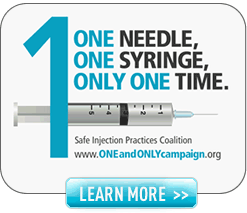We would like to thank Dr. Mudasir Firdosi for helping to highlight Hepatitis C as a truly global issue. This is re-printed from a post which appeared in mid-May.
Kashmir valley is witnessing another disaster in the form of Hepatitis C epidemic. In some villages in Kokernag area, the number of cases is around 40% of the total population. In spite of media pressure, and demand from local population, authorities are still contemplating curbing the further spread of this infection. Similar scenario exists in other districts of the valley like Shopian, Kupwara, and Srinagar.
Hepatitis C is not transmitted by routine personal contact and there needs to be an actual transfer of the virus via blood, blood products and body fluids, from one person to another. From the sociodemographic profile of the rural population, one can easily exclude intravenous drug abuse or sexual contact as the cause of the current epidemic in majority of cases.
The unsafe use of syringes and instruments by health professionals, dentists, chemists and quacks does explain this explosive nature of the problem. The situation is made worse by the lack of training and accountability, unsafe sterilisation procedures or no sterilisation at all. The reuse of disposable syringes is quite common and people are not used to questioning the unsafe practice. Stitching of common injuries at health centers is another common mode of infection. The practice of circumcision in our community puts children at high risk if proper precautions are not taken. Unsafe dental practices and mushrooming of dental quacks is another worrying reason.
Use of injections is a common practice more so in villages. Even for minor ailments, people prefer to get medication by injection than by oral route. There is also a practice of using intravenous fluids in villages for no apparent reason. The erroneous beliefs in the superiority of injections compared to pills, or due to unscrupulous providers /quacks, who like to inject people because of greed for extra money, the problem is accentuated.
People should take extra precautions when seeking help for any medical condition. When your doctor prescribes an injection, ask if you can get along without any medicine, or if an oral alternative is available. Many conditions, such as cold, flu, dry cough, and diarrhea are better treated without injected medicines.
Most drugs, and other substances, can be taken orally, and should be injected only in rare situations, like if someone is unconscious, or vomits so much that oral medication will not stay down. Vitamins, glucose, paracetamol and other drugs to reduce temperature, most pain-killers, treatments to stop diarrhea or vomiting, medicines to treat asthma, antibiotics (with a few exceptions, such as penicillin) should be taken orally.
Only new and disposable syringes and needles taken from a sealed package should be used. Syringes should not be kept at home for reuse even on the same patient because it is potential source of infection. If for any reason syringe or needle has to be reused, ask if it has been autoclaved or boiled.
Single dose vial should be used as much as possible, which is a small bottle with medicine for one injection only, so that there is no need to reuse the medication on same or other patient. Multi-dose vials, with medicine for many injections, are often used by dentists and anesthetists when giving local anesthesia, like during removal of a tooth. This can become a source of infection if both the needle and syringe is not changed between the patients.
If no single dose vial is available, see that your doctor takes medicine from a new multi-dose vial opened in front of you. This may not always be possible and many doses are taken out from same bottle. Some people have the bad habit to only change the needle (and not the whole syringe) between two injections for a same patient, (and only change the whole syringe in between patients), which contaminates the vials because of the reflux mechanism, and you are placed at risk of getting contaminated with the virus (HIV, Hepatitis B & C) or bacteria of the patients before you, including drug resistant bacteria.
Recent investigations in the USA on nosocomial epidemics of Hepatitis C showed that badly trained, unscrupulous care givers only changed the needle and not the whole syringe to re-inject a same patient from multiple dose drug vials. In the process of injection, when the needle is pulled out, microscopic quantities of blood (not visible with the naked eye), get back up into the syringe. Thus when only the needle is changed and syringe is reused, multi-dose vial gets contaminated with the blood from the syringe possibly containing the infection.
Then, when the vial is used for a new patient, even if a totally new sterile syringe is used, the new patient is at risk of getting infected with the virus/bacteria of the patient or patients who came before him for treatment (and many microorganisms remain viable for days in microscopic drop of blood). In 1996, even in North America, more than half of anesthesiologists had those bad ‘dirty’ practices. Many health care givers are not conscious of the danger of this practice. So both needle and syringe should be changed with every withdrawal of medicine from the vial.
Another option is to take injections from pre-filled disposable syringes– which are disposable syringes combined with single-dose vials, or single dose cartridges. ‘Smart syringes’ which include a manufacturing system which makes them definitively non-reusable, but they are unlikely available due to cost issues.
Many people give injections – not only doctors and nurses, but also pharmacists, traditional healers, family, and friends. No general statements can be made about who gives safe injections. If a trained provider respects your requests, uses a new syringe and needle, and takes medicine from a single-dose vial, you are probably safer with the trained provider. But if the trained provider will not do so, you may be safer with an untrained provider who will listen to you.
Finally health care providers need training around infection control and sterilisation so that this dangerous epidemic is put to a halt before it is too late. Every new case is a potential source and the only way to break the cycle of further transmission is to practice honestly and safely. It is your right to demand safe health care and question where ever you are in doubt. A five rupee syringe can save you money, can save your health and ultimately your life.
mudasirfirdosi@gmail.com

